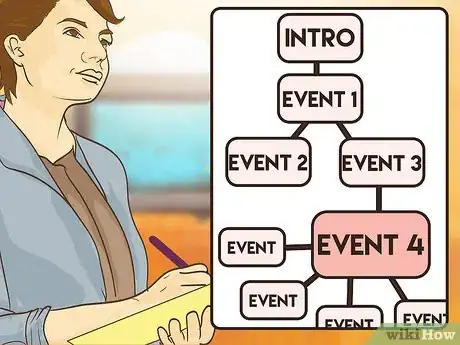This article was co-authored by Stephanie Wong Ken, MFA. Stephanie Wong Ken is a writer based in Canada. Stephanie's writing has appeared in Joyland, Catapult, Pithead Chapel, Cosmonaut's Avenue, and other publications. She holds an MFA in Fiction and Creative Writing from Portland State University.
There are 10 references cited in this article, which can be found at the bottom of the page.
wikiHow marks an article as reader-approved once it receives enough positive feedback. In this case, 92% of readers who voted found the article helpful, earning it our reader-approved status.
This article has been viewed 66,670 times.
Book series seem to be everywhere these days, whether filling the shelves at your local library or inspiring movies at your local cinema. A compelling series pulls in readers, who identify with the main characters and yearn to spend more time with them as the series progresses. Series readers can be unflinchingly loyal, yet they are observant readers, who will bristle at inconsistencies in plot or character traits. To write a successful book series, you must develop interesting characters, write a plot that can be sustained over several books, and create a setting that your readers will want to visit again and again.
Steps
Planning Your Book Series
-
1Choose a genre for the series. Some genres, such as fantasy, science fiction, and mystery, are more amenable to a series than others, like romance or commercial fiction. Decide whether your concept fits into the former or the latter.[1]
- Children’s and young adult fiction are other genres that are suitable for series building.
- Some publishers prefer fantasy series over individual fantasy novels, because fantasy series tend to sell better than standalone fantasy books.[2]
-
2Consider the type of series you will write. You will have to decide whether you are interested in writing one large story broken into several books, such as the Harry Potter series or a group of stand-alone books featuring the same characters, such as Agatha Christie’s Hercule Poirot mysteries.[3] Making this decision will help you figure out whether you will plot each book separately, or whether you will try to have an overarching storyline between the books.
- Did you just finish a novel and don’t want to say goodbye your main characters? Or, have you developed a fantastic plot that is so wide-ranging it needs to be told over several installments? The former motivation could lead to a long-running series, like a group of mystery novels, while the latter could lead to a trilogy.[4]
- You will also need to figure out whether you will have an ensemble cast that appears throughout the series, or whether you will primarily have a main character who meets new characters in each book.
Advertisement -
3Make a writing timeline. To help you plan out the series, create a writing timeline with deadlines and due dates. Determine how much time per week or per day you are going to devote to writing the book series. Have deadlines for completed chapters or for a certain page count so you are encouraged to complete the book series.[5]
- For example, you may have a goal page count per week that you have to hit. Or you may have a certain number of chapters you have to complete every month so you can get the book series done.
- You will need to be prepared to write and publish frequently as a series writer. Your audience will want to know what happens next to your characters. You also don’t want your readers to move on to other books or series if they get tired of waiting for your next installment.
Creating Identifiable Characters
-
1Make the main character active and likeable. Active characters are more interesting and relatable than passive ones. The protagonist in the series should be motivated and make decisions, for better or worse. They should be active participants in the plot and their decisions should affect the action in the book series.[6]
- Your main character will sustain you, and your readers, through the length of your series, so make sure it is someone who will not wear out their welcome. Your protagonist will be viewed as a member of your readers’ family or a close friend. Readers will care about what happens to them.
- For example, you may have a main character who is a teenage high schooler who wants to win a spelling tournament at their school. This way, your protagonist is motivated by the need to win.
-
2Give your main character an interesting backstory. To make your protagonist feel relatable and believable, give them a backstory. Backstory is a character's past actions or experiences. It usually affects or informs their behavior in the present.[7]
- For example, your character may have an addiction or a divorce in their backstory. This can make them seem more real. You may have a protagonist that have a difficult childhood or that has struggles with their identity or their sexuality.
- Keep in mind that issues like an addiction or a medical condition will need to ring true throughout your series. In other words, you can’t have your character obtain a “miracle cure” if you’re tired of writing about this problem by the third novel.
-
3Determine your main character's occupation. If your main character is an adult, they may have a specific profession. If your main character is a child, they may be occupied by going to school or by living at home. Decide how your main character occupies their time day to day and add this to their backstory.
- One option is to go for a profession where your main character can interact with a variety of people. This will increase your ability to create new problems for your character to solve that relate to their job.
- For instance, your protagonist could be a hair stylist who continually finds himself drawn into the mysteries and personal lives of his clients. Or, she could be a corporate lawyer whose expertise in white collar crime makes her sought out by the police for help on new cases.
-
4Create deep personal relationships for the main character. If your protagonist ages throughout the series, make sure they also develop their skills and perceptions as they age. Their relationships with others should also deepen and shift as they get older.[8]
- For example, maybe your main character has a best friend that they grew up with and are still close to. This relationship could then be central to their life and affect their decisions or experiences. Their best friend may turn out to be a con man, for example, which will complicate the main character's relationship to them.
-
5Develop compelling minor characters. Regardless of whether you’re writing a long-term mystery series or a science fiction trilogy, your protagonist will encounter recurring characters throughout your series. By giving these characters the attention they deserve, you will be able to surround your protagonist with a interesting ensemble.[9]
- Minor characters are a useful way to introduce personalities that can challenge or work against the main character.
- Recurring characters can also be used to offer occasional comic relief if your main character is typically involved in solving grisly murders.
-
6Keep a character bible. Maintaining consistency throughout your series is one of the most important jobs you will have as a series writer. To assist you with this, create a character bible that includes information on ages, birthdays, physical characteristics, personality types (such as nervous habits or annoying behavior), and back stories of each character.[10]
- Remember that characters you introduce in the first book will probably play a role in subsequent titles. For instance, if your main character is divorced with two children, those children will have to play some role in future books.
- Family trees can also be useful for keeping track of the extended family of your main character.[11]
- It is useful to keep your character information all in one place, either in a notebook or on a spreadsheet.
Developing Interesting Plots
-
1Think about the whole series while writing the first book. When you embark upon writing a series, you need to be aware of where you are heading and what problems your characters will encounter in the upcoming books. That way, you can include teases and clues in the first book that will delight readers and encourage them to keep reading the series. Set up the key points you want to cover in each book, including the ending.[12]
-
2Keep in mind how the series will end. If you are writing a shorter series, like a trilogy, thinking about the ultimate conclusion will help you drive the plot in that direction in a believable way.
- If you know the course of action for the series, it will be much easier to write how your characters will get to the final resolution.
-
3Make your books self-contained, yet part of the whole. One challenge of writing a series like a trilogy, for instance, is deciding what to resolve in each installment and what problems to carry through the series. Each book should have its own plot and its own conclusion, but it should also foreshadow events to come.[15]
- For example, you may have a series of books that are linked with the same characters, settings, and problems. Or you may have a series of books that focus on different characters within the same world or setting.
- Keep some problems unresolved in the first book. Allow the characters to grow.[16]
- Don’t assume that readers of subsequent books will have read the first one. Include background information on characters and references to previous plots and situations where necessary.[17]
-
4Create interesting subplots. Subplots are a good way to both drive the action and develop your characters further. Incorporating a romantic subplot into a mystery thriller, for instance, introduces more characters and could help show another side to your protagonist outside of their job.
- Subplots are also useful in giving the reader some satisfaction of plot resolution. In other words, if your overarching plot carries through several novels, the resolution of a subplot or two can give your reader a sense of satisfaction.
- For example, you may have a minor character subplot where a minor character gets into a fight in your book. This could then lead to repercussions for the minor character and affect the main character in some way.
-
5Make the ending strong and compelling. Offer clues to the final resolution throughout the series. The ending of the series should feel compelling and realistic to your reader. Your main character should be changed or feel a shift in some way by the end of the series.[18]
- Avoid having a surprise or twist at the end that does not feel earned. Your reader may find it unsatisfying if a new concept is introduced at the end of the book that then saves the day.
- For example, you may have an ending that answers a few questions presented in book one of the series. But you may leave a few questions unanswered, allowing your reader to feel satisfied but also curious about what might have happened to a few minor characters or to the main character's relationships in the books.
Considering Setting and Time
-
1Create a setting readers will want to revisit often. Whether it is a rugged mountain town or the halls of Congress, you will need to create a world that is interesting and complex enough to draw your readers in again and again. Your main character should also be a natural part of their environment.[19]
- Setting can be used to establish a mood throughout your series. For example, if you are writing a gritty detective novel, you could focus on the dark alleyways and seedy underbelly of an urban area.[20]
- If you are writing a science fiction or fantasy novel, your setting will involve a fair amount of world building. You will be creating a new culture, government, terrain, and even climate.
-
2Maintain consistency for your setting. Similar to a character bible, you will need to create an ongoing list of information regarding key settings in your series.
- Information on your list should include names of key buildings and streets; distances between landmarks, stores, and restaurants the characters frequent; and directional data, like which streets run north/south and which are east/west.[21]
- You should also include information on the paint color and furnishings of rooms commonly featured.
-
3Decide on how you will address the passage of time. You have a few options to consider when writing a series. Your character can age throughout the series relatively quickly, or they can remain pretty much the same age throughout (as in primary characters in long-running mystery series).
- If your characters will age significantly over the course of the series, keep in mind that other minor characters will need to age accordingly.
Community Q&A
-
QuestionHow do I write about a setting I don't know about?
 Community AnswerDo some research online or at the library about this setting, use your imagination, or choose a new setting that you know a little more about.
Community AnswerDo some research online or at the library about this setting, use your imagination, or choose a new setting that you know a little more about. -
QuestionHow do you stick to writing it? Every time I try to write a book, after about three hours, I start something else. What should I do?Find your writing style first. Find a subject or genre you are passionate about, then you won't dread writing. If you still have trouble sticking to it, try listening to music while writing.
-
QuestionWhen writing a series of fictional books, do I start with a main plot that will unravel in the last book, and then think of milestones along the way to make it into three books, or do I just start and see where it goes?
 Community AnswerIt depends on your preference, some people plan their series, while others don't plan. It is better to plan your series, so that you can find any potential plot holes, or improbabilities ahead of time.
Community AnswerIt depends on your preference, some people plan their series, while others don't plan. It is better to plan your series, so that you can find any potential plot holes, or improbabilities ahead of time.
References
- ↑ https://writersedit.com/ultimate-guide-how-to-write-a-series/
- ↑ https://writersedit.com/ultimate-guide-how-to-write-a-series/
- ↑ http://www.darcypattison.com/revision/how-to-write-a-book-series/
- ↑ http://www.writing-world.com/fiction/series.shtml
- ↑ http://www.thecreativepenn.com/2013/11/21/writing-a-novel-series/
- ↑ http://www.writing-world.com/fiction/series.shtml
- ↑ http://thewritepractice.com/fiction-series/
- ↑ http://www.forbes.com/sites/booked/2010/11/13/what-makes-a-book-publisher-drool-can-you-say-series/#7cba33e578fa
- ↑ http://www.thecreativepenn.com/2013/11/21/writing-a-novel-series/
- ↑ http://writerunboxed.com/2013/12/01/practical-tips-for-writing-a-series/
- ↑ http://www.writing-world.com/fiction/series.shtml
- ↑ http://thewritepractice.com/fiction-series/
- ↑ http://writerunboxed.com/2013/12/01/practical-tips-for-writing-a-series/
- ↑ https://writersedit.com/ultimate-guide-how-to-write-a-series/
- ↑ https://www.scribendi.com/advice/plotstructuresforbooksinaseries.en.html
- ↑ http://www.thecreativepenn.com/2013/11/21/writing-a-novel-series/
- ↑ https://www.scribendi.com/advice/plotstructuresforbooksinaseries.en.html
- ↑ http://literaryterms.net/deus-ex-machina//
- ↑ http://www.writing-world.com/fiction/series.shtml
- ↑ https://writersedit.com/ultimate-guide-how-to-write-a-series/
- ↑ http://writerunboxed.com/2013/12/01/practical-tips-for-writing-a-series/
About This Article
To write a book series, start by outlining all of the key events that will take place throughout the series, including the ending, so you can tease and hint at them throughout the books. However, make sure that each book has it's own contained plot and conflict that gets resolved so that each installment leaves your readers satisfied. Also, as you're writing, keep detailed outlines for each character you introduce so that you're being consistent about their traits and personal history throughout the series. To learn how to come up with great characters for your book series, scroll down!















































































